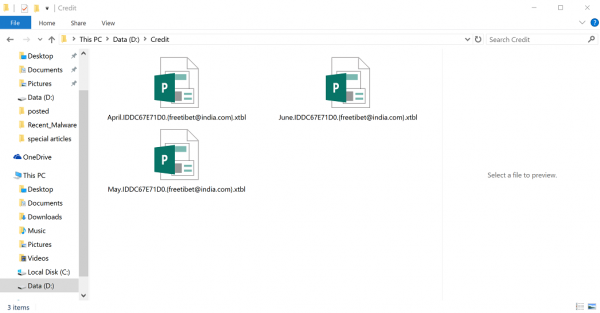XTBL file virus has long since been circulated by a number of hacking groups. The program under review is an encrypting virus. It holds your data scrambled demanding a fee to undo the encryption. Unfortunately, it is not a scary fraud; it is a grim reality for many users.

Meanwhile, as the IT security industry applies enormous effort to come up with the ultimate decryption tool to recover data fully and free of any fees to the crooks, there is no guarantee the victims will recover their data even if the ransom requested is paid. Cases have been reported of the ransomware server failing to issue the key required for the data decryption even after the receipt of the amount requested. Some unfortunate victims have no choice as the data ransomed has too much value for them.
The infection is not a brand new malicious product. Quite in contrary, both the idea of holding computer data as a hostage and the way it is implemented do not make a breakthrough in the black hat hackers’ business. The XTBL Trojan under review is basically a replica of other notorious ransom threats. Its scripts partially match that of Encoder, Troldesh, Shade. It belongs to the Win32/Filecoder family.
The crooks behind the XTBL file virus could be grouped into two categories: those who developed the scamware and those who drop it. The developers make it available as a service. That is, the droppers are free to adjust the amount of ransom and other settings. However, so far, the amount claimed is around USD 500, payable in Bitcoins. No deviations have been observed. The droppers are also able to adjust other characteristics such as the lingering period, during which the ransomware is not active. The above span is meant to bewilder the malware experts so that they would not easily identify the infection vector.
The files encrypted get their name modified as .xtbl extension is added. That is not the most critical modification. The data is totally scrambled using a sophisticated encryption algorithm. That is the greatest challenge.
Once the job is done, the ransom reminder is created. It is available as a text message and as audio, the latter may play in the background. Cyber criminals request to contact them at [email protected].
The victims are advised to follow the .xtbl file virus removal and post-removal recovery tips as outlined below. Others are advised to make use of regular backups to offline media.
Automatic removal of .xtbl ransomware
The benefits of using the automatic security suite to get rid of this infection are obvious: it scans the entire system and detects all potential fragments of the virus, so you are a few mouse clicks away from a complete fix.
- Download and install recommended malware security suite
- Select Start Computer Scan feature and wait until the utility comes up with the scan report. Proceed by clicking on the Fix Threats button, which will trigger a thorough removal process to address all the malware issues compromising your computer and your privacy.
Unlock .xtbl files
.xtbl represents a unique category of malicious software whose attack surface reaches beyond the operating system and its components, which is why removing the virus itself is a part of the fix only. As it has been mentioned, it encrypts one’s personal information, so the next phase of the overall remediation presupposes reinstating the files that will otherwise remain inaccessible.
-
Launch data recovery software
Similarly to the rest of its fellow-infections, .xtbl most likely follows an operational algorithm where it erases the original versions of the victim’s files and actually encrypts their copies. This peculiarity might make your day, because forensics-focused applications like Data Recovery Pro are capable of restoring the information that has been removed. As the virus further evolves, its modus operandi may be altered – in the meanwhile, go ahead and try this.
-
Take advantage of Volume Shadow Copy Service
This technique is based on using the native backup functionality that’s shipped with Windows operating system. Also referred to as Volume Snapshot Service (VSS), this feature makes regular backups of the user’s files and keeps their most recent versions as long as System Restore is on. XTBL virus hasn’t been found to affect these copies therefore the restoration vector in question is strongly recommended. The two sub-sections below highlight the automatic and manual workflow.
- a) Use Shadow Explorer
Shadow Explorer is an applet that provides an easy way of retrieving previous versions of files and folders. Its pro’s include an intuitive interface where the computer’s entire file hierarchy is displayed within one window. Just pick the hard disk volume, select the object or directory to be restored, right-click on it and choose Export. Follow the app’s prompts to get the job done.

- b) Use file properties
Essentially, what the above-mentioned Shadow Explorer tool does is it automates the process that can otherwise be performed manually via the Properties dialog for individual files. This particular approach is more cumbrous but just as effective as its software-based counterpart, so you can proceed by right-clicking on a specific file, which has been encrypted by XTBL ransomware, and selecting Properties in the context menu. The tab named Previous Versions is the next thing to click – it displays available versions of the file by date of the snapshot creation. Pick the latest copy and complete the retrieval by following the prompts.

-
Data backups work wonders
Ransomware like .xtbl isn’t nearly as almighty and destructive in case you run regular file backups to the cloud or external data media. The virus itself can be completely removed in a matter of minutes, and the distorted information can then be just as easily recovered from the backup. Luckily, this is a growing trend, so ransom Trojans are hopefully going to become less subversive in the near future.
Verify thoroughness of the removal
Having carried out the instructions above, add a finishing touch to the security procedure by running an additional computer scan to check for residual malware activity
